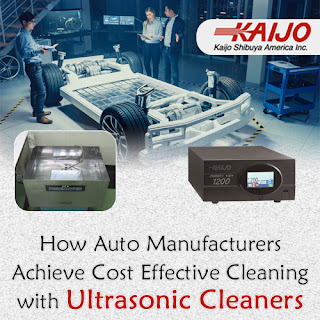Automotive parts are often contaminated by the manufacturing process, so manufacturers have to clean the parts they produce before using them, processing them further or delivering them to customers.
These automotive parts often have complex shapes or hard-to-access cavities, that's why cleaning them in traditional methods can be costly, labor-intensive, and time-consuming. Fragile parts and parts with delicate coatings may be damaged by manual cleaning methods or caustic cleaning chemicals.
Automotive ultrasonic cleaners are the ideal alternative to the traditional cleaning methods, such as manual scrubbing and soaking in cleaning chemicals.
Ultrasonic cleaning systems are made up of ultrasonic generators, transducers, and cleaning tanks. The ultrasonic transducer is placed in the cleaning solution and generates sound waves responsible for the cleaning action. The sound waves penetrate everywhere, even inside threaded holes, along cracks and inside nozzles. As a result, parts with complicated shapes are cleaned quickly and easily.
The ultrasonic generator produces the frequency at which the system operates. One of keys to successful cleaning is choosing the right frequency for certain parts to be cleaned. Low frequencies deliver powerful cleaning action for machined steel parts, cast metal parts, and metal fasteners. Medium frequencies can safely clean metal parts that are softer, plastic parts, or parts with a delicate coating. The highest frequencies can clean delicate nozzles, gaskets, and other fragile parts without damaging them. For general purpose applications, a system that can operate at several frequencies may be the best solution.
With automotive ultrasonic cleaning, there's no need for manual scrubbing of the parts or soaking them into a cleaning solution. There's also no need for caustic chemicals, therefore reducing chemical costs. If all parts are contaminated with a specific material from the manufacturing environment, a heater can be fitted into the cleaning tank to heat the cleaning solution and soften hard, greasy, or oily deposits. A mild detergent can also be added to the cleaning solution to speed up cleaning.
The ultrasonic cleaning process is safe and does not need constant monitoring. All that manufacturing facility workers can do is to place the parts to be cleaned in the ultrasonic bath, set a timer, and come back later to remove the newly cleaned parts. Ultrasonic cleaners can replace traditional cleaning methods for most automotive part cleaning applications.
If you have questions, read the complete article “How Auto Manufacturers Achieve Cost Effective Cleaning with Ultrasonic Cleaners”, for additional information. Contact Kaijo Shibuya at 408-675-5575 or email info@kaijo-shibuya.com if you have other questions or would like to set up a free consultation.


No comments:
Post a Comment